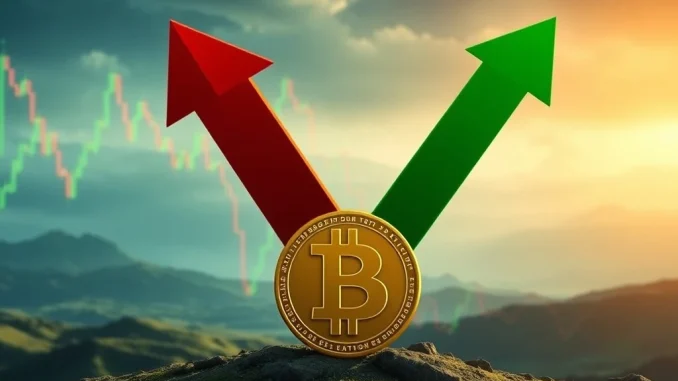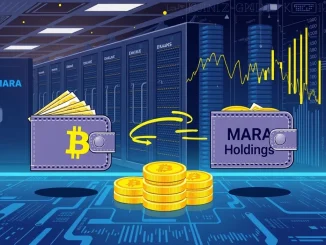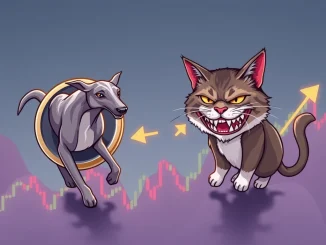
The cryptocurrency world is buzzing with anticipation as Bitcoin news reveals a fascinating standoff: massive bearish positioning in the futures market colliding head-on with robust accumulation on spot exchanges. This intense tug-of-war has set the stage for what could be a monumental Bitcoin short squeeze, a scenario that could rapidly propel the price upwards.
The Futures Frenzy: Why Bearish Bets Are Piling Up
For weeks, the derivatives market has been signaling a strong bearish sentiment. We’ve seen a staggering surge in Open Interest (OI) for Bitcoin futures, reaching an unprecedented all-time high of $44.68 billion. This metric reflects the total number of outstanding derivative contracts that have not been settled, and its significant increase indicates a widespread conviction among traders that Bitcoin’s price is set to fall.
Further reinforcing this bearish outlook, the Futures Net Position metric has plunged deep into negative territory. This suggests that the majority of new positions being opened are short bets, rather than long ones. CryptoQuant analyst Axel Adler highlighted this divergence, noting that the Open Interest Net Position has breached $100 million, marking the highest bearish pressure observed in three weeks. Historically, such extreme bearish positioning can precede one of two outcomes: a sustained price decline or a sharp short covering rally.
Here’s a breakdown of the futures market dynamics:
- All-Time High OI: $44.68 billion, indicating unprecedented market engagement.
- Negative Net Position: Signals a dominant shorting bias among traders.
- Increased Bearish Pressure: Open Interest Net Position exceeding $100 million points to significant downside expectations.
Exchange Buying: The Silent Accumulation
While futures traders are betting against Bitcoin, on-chain data paints a strikingly different picture. Exchange-level metrics reveal a contrasting narrative of quiet, persistent accumulation. On July 25, the Exchange Netflow, which measures the net amount of Bitcoin moving onto or off exchanges, dipped to a monthly low of -16.9k BTC. A negative netflow signifies that more Bitcoin is being withdrawn from exchanges than deposited, a classic indicator of buying and holding behavior.
This withdrawal trend suggests that institutional investors and large holders are actively accumulating Bitcoin, moving their newly acquired assets into cold storage or self-custody solutions. This reduces the readily available supply on exchanges, which can create upward price pressure if demand increases. This accumulation is a strong counter-signal to the bearish sentiment seen in the futures market, creating a fragile but fascinating balance within the broader Bitcoin market.
Is a Bitcoin Short Squeeze Imminent?
The clash between aggressive futures shorting and steady spot accumulation sets the stage for a potential Bitcoin short squeeze. A short squeeze occurs when the price of an asset suddenly surges, forcing traders who have bet against it (short sellers) to buy it back to limit their losses. This buying pressure, in turn, pushes the price even higher, creating a cascading effect.
If the sustained exchange buying continues to absorb the selling pressure from the futures market, it could trigger this exact scenario. Analysts are closely watching key levels, suggesting that a successful squeeze could propel Bitcoin back toward the $117,000 mark. Conversely, if bearish momentum gains further traction, the price could test the $110,000 support level. The current market dynamic is a high-stakes game, with significant implications for Bitcoin’s near-term trajectory.
What Does This Mean for Bitcoin Price Prediction?
Navigating the current market requires a nuanced understanding of conflicting signals. While the short-term outlook is fraught with volatility, the long-term Bitcoin price prediction remains a subject of intense debate among whales and institutional players.
- Short-Term Volatility: Bitcoin’s price dipped below $116,000 on July 16, impacting major crypto stocks like Coinbase and MicroStrategy. However, the 6% pullback in July 2025 is still within historical volatility norms, suggesting the correction could stabilize.
- Whale Activity: Large holders (1,000–10,000 BTC) saw a 2.7% decline in holdings during the recent sell-off, indicating some profit-taking or risk-off behavior. Yet, some prominent whales are placing massive bets on a year-end rally to $200,000 through complex options strategies, signaling strong long-term confidence.
- Institutional Confidence: Companies like Volcon Inc. are doubling down on Bitcoin, as evidenced by their purchase of 3,183 BTC at an average price of $117,697. This significant investment signals continued institutional confidence in Bitcoin’s rebound potential despite current turbulence.
The market’s next significant move hinges on whether the relentless exchange accumulation can overpower the aggressive futures shorting. Traders and investors alike are keenly monitoring the Open Interest Net Position and Exchange Netflow for definitive directional clues. The interplay between these factors creates a high-probability scenario for continued volatility, with the ultimate outcome dependent on institutional positioning and broader macroeconomic cues.
The Road Ahead: Navigating the Bitcoin Market
The current state of the Bitcoin market is a testament to its dynamic and often unpredictable nature. The battle between bearish sentiment in the derivatives market and bullish accumulation on spot exchanges is creating a tense equilibrium. While the threat of further downside remains if bearish momentum accelerates, the potential for a dramatic short squeeze offers a compelling upside.
For investors, this period calls for careful observation and strategic decision-making. Understanding the divergence between on-chain data and futures market sentiment is crucial. Whether Bitcoin breaks out upwards due to a short squeeze or consolidates further before a clearer trend emerges, one thing is certain: the cryptocurrency market continues to be a captivating arena for those tracking its every move.
Frequently Asked Questions (FAQs)
Q1: What is a Bitcoin short squeeze?
A Bitcoin short squeeze occurs when the price of Bitcoin rapidly increases, forcing traders who had bet on its price falling (short sellers) to buy back their positions to cover their losses. This sudden buying pressure further accelerates the price increase.
Q2: What does ‘Open Interest (OI)’ mean in Bitcoin futures?
Open Interest (OI) in Bitcoin futures refers to the total number of outstanding derivative contracts (long or short) that have not yet been settled or closed. A high OI often indicates significant market participation and conviction in a particular price direction.
Q3: How does ‘Exchange Netflow’ indicate accumulation?
Exchange Netflow measures the net amount of Bitcoin moving onto or off centralized exchanges. A negative netflow means more Bitcoin is being withdrawn from exchanges than deposited, suggesting that investors are buying Bitcoin and moving it to private wallets for long-term holding, indicating accumulation.
Q4: What are the key price levels to watch for Bitcoin?
According to the analysis, key price levels to watch are $117,000 as a potential upside target if a short squeeze occurs, and $110,000 as a significant support level if bearish momentum persists.
Q5: Are institutional investors still confident in Bitcoin despite volatility?
Yes, despite recent price volatility, institutional actions like Volcon Inc.’s significant Bitcoin purchase and some whales’ long-term options strategies suggest continued confidence in Bitcoin’s long-term potential and a belief in a future rally.



